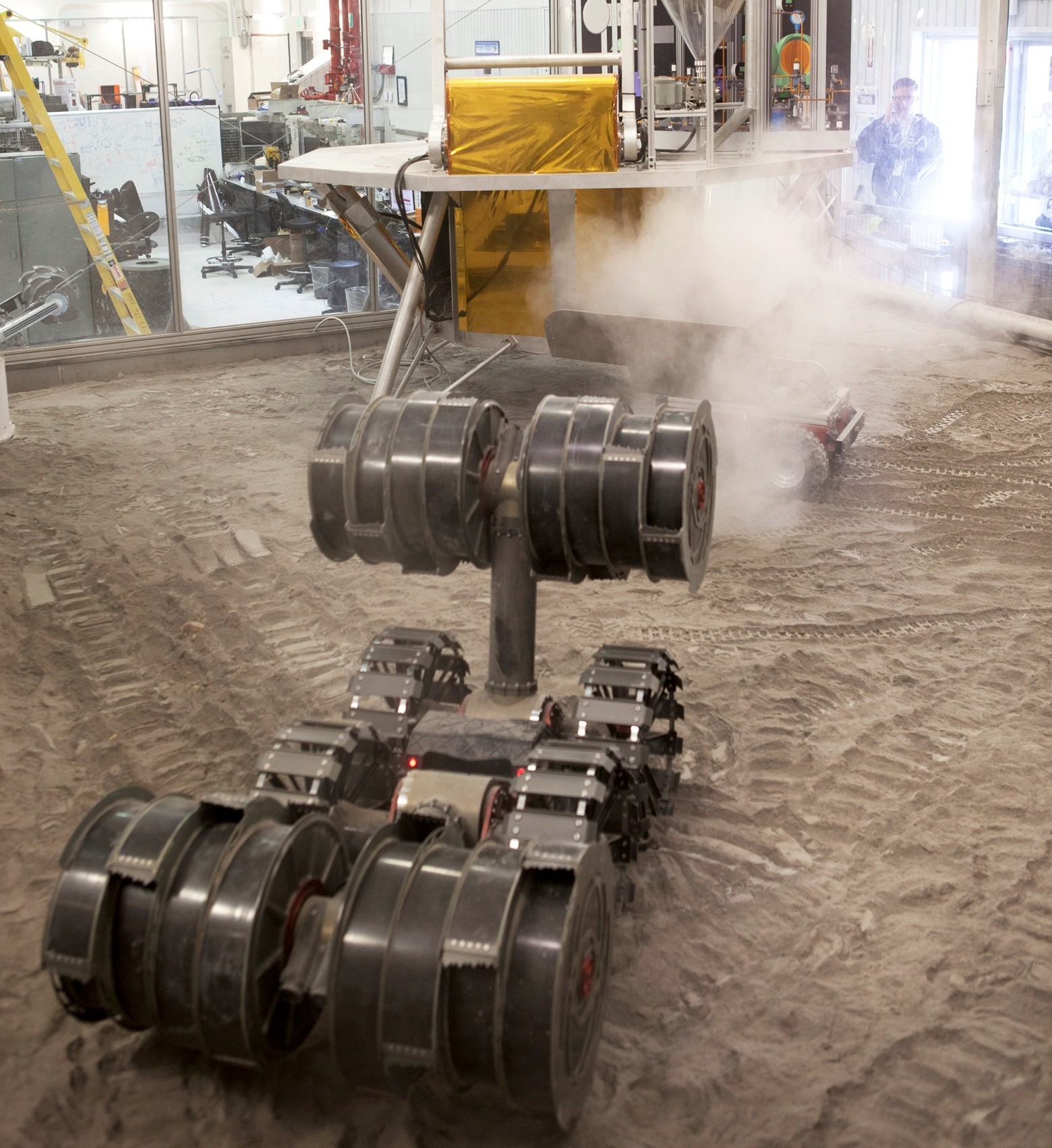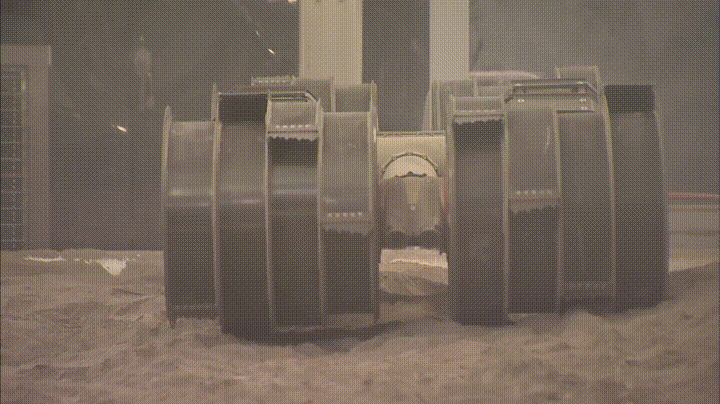NASA Tested a Rotary Excavator for Mars

Tests of the Martian excavator RASSOR 2.0 in the Space Center. Kennedy. Photo: NASA / Dimitri Gerondidakis
In preparation for the Mars Settlement Program , tests of robots that the first colonists will most likely need will continue. In particular, engineers and scientists are now testing the performance of devices for the extraction and processing of local resources . There are three main areas in this area:
- recycling;
- resource extraction from the Martian regolith and the atmosphere;
- growing plants on the Martian soil.
People on Mars will not be able to receive from Earth all the necessary resources for the survival and development of the colony. Even if Ilon Mask realizes his fantastic plan - he will launch reusable transport ships and reduce the cost of delivering goods to $ 140,000 per ton - anyway, some resources will have to be extracted on Mars, there is no other way out. Production of 1 kilogram of fuel on Mars saves 250 kilograms on a cargo ship from the Earth, according to NASA calculations . Delivery of goods to Mars takes from six to nine months. Even the Mask plan provides for the extraction of fuel on Mars for refueling a transport ship before returning to Earth.

Variants of Martian fuel for reusable transport ship. Slide from the presentation by Ilona Mask

The process of producing fuel on Mars. Slide from Ilona Mask 's presentation
In addition to fuel, colonists will need other resources. For example, you need materials for the construction of houses and office space.
The main source of useful resources on Mars is regolith, residual soil, which is a product of weathering of the rock, which covers the surface of the planet everywhere.
The composition of the Martian regolith
The composition of the soil is different in different places. The main component is silica (20-25%), containing an admixture of hydrates of iron oxides (up to 15%), giving the soil a reddish color. There are significant impurities compounds of sulfur, calcium, aluminum, magnesium, sodium (a few percent for each). The concentration of water ice in the ground - up to 2% by weight.

The Curiosity rover from the Namib Martian dune takes regolith samples for analysis on January 19, 2016. Photo: NASA / Jet Propulsion Laboratory-Caltech
Thus, in the Martian regolith there are many materials useful for the colony. The question is how to mine them. NASA experts take into account that robots will have to work in adverse environmental conditions. The temperature near the poles drops to -125 ° C, and near the Martian equator on a summer day can rise to quite comfortable for a person + 21 ° C. The atmosphere of Mars is about 95% carbon dioxide.
It is very important to land the ship in a suitable place where water ice is definitely present in the ground. To obtain such confidence, it is required to conduct preliminary reconnaissance of the area. NASA is planning a remote scan of soil from orbit. Orbital station for reconnaissance tools will be similar to the Mars Reconnaissance Orbiter- NASA's multifunctional interplanetary station, which began work in the orbit of Mars in November 2006 and is engaged in, among other things, the search for surface water.
After receiving the reconnaissance data from the orbiter, the rover reconnaissance rovers will be sent to the area of the proposed construction of the base to take soil samples and finally confirm that the regolith is suitable for the extraction of useful resources.
Preparation for the extraction of resources on Mars will be carried out within the framework of the lunar mission of the Resource Prospector - the first mission in the history of mankind on the extraction of minerals on other celestial bodies other than Earth. It is assumed that this mission will be carried out in the early 2020s. The robot will be equipped with tools for studying the composition of the soil and sampling.

The prototype of the robot Resource Prospector, which is planned to launch on the moon. Photo: NASA

Resource Prospector Robot takes a sample of the soil. Photo: NASA
Another device will be engaged in the mining and processing of the regolith on Mars. A machine called the RASSOR (Regolith Advanced Surface Systems Operations Robot) is being tested . This machine is equipped with many small buckets with jagged edges. They rotate, gnawing into the Martian soil, gradually grabbing regolith and dumping it into the collection tank. This design is called a rotary excavator - a continuous-action excavator on tracked undercarriage equipment, which develops the soil with the help of buckets fixed on the rotor wheel.

After collecting the regolith, it is heat treated in a furnace with the release of water, hydrogen and oxygen. Raw materials can also be used for 3D printing of shelters for settlers and other buildings.
Tests of a rotary excavator in the Space Center. Kennedy are shown on video.
Growing plants
The pH ratio and some other parameters of the Martian soils are close to terrestrial, and it is theoretically possible to grow plants on them. Researchers believe that the Martian soil contains the necessary elements to sustain life. The acidity level of alkaline soil pH 7.7 is quite common on Earth and does not interfere with the cultivation of plants.
On Earth, several research groups are now exploring which plants are best suited for growing on Mars. For example, in March 2016, biologists from the Research Center of the University of Wageningen (Netherlands) completed the second experimenton growing vegetables and other plants on the soil that simulates the soil of Mars and the Moon. It turned out that when manure is added and the soil is moistened, at least 10 crops grow well there. Scientists have harvested tomatoes, peas, rye, arugula, radish, leek, spinach, garlic, green onions and watercress.
NASA is also conducting experiments on growing plants on the ISS. A year ago, astronauts on the ISS tried lettuce grown at the station , and in January 2016 the flower blossomed on the ISS for the first time .
Scientists believe that on Mars you can grow a large number of crops, including tomatoes.
Recycling
A dedicated group of NASA is developing a technology for recycling that will leave the human colony on Mars. All kinds of waste will be turned into useful products, including biological waste, packaging and garbage. For example, they are supposed to produce methane.
In the photo, NASA chemical engineer Annie Caracco demonstrates the details of a biological reactor for recycling biofuel on Mars.

Experiments have shown that up to 700 grams of methane can be obtained from a kilogram of garbage.
Judging by the experiments of NASA, humanity is close to ensuring that the Martian colony is completely independent of Earth.
